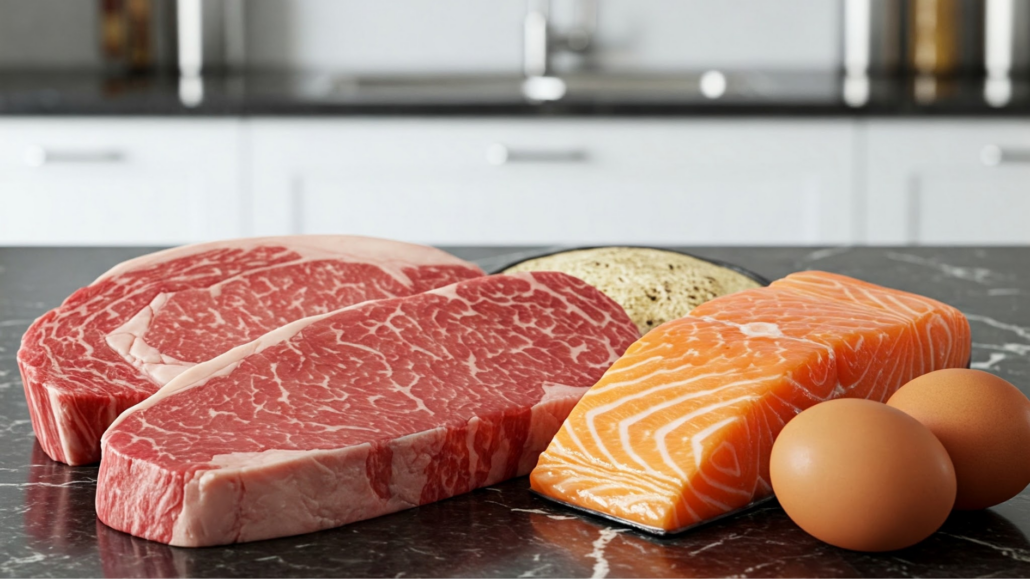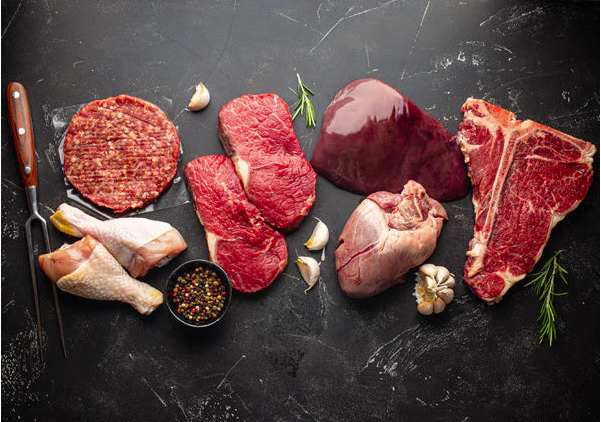We include products in articles we think are useful for our readers. If you buy products or services through links on our website, we may earn a small commission.
Are Humans Carnivores?
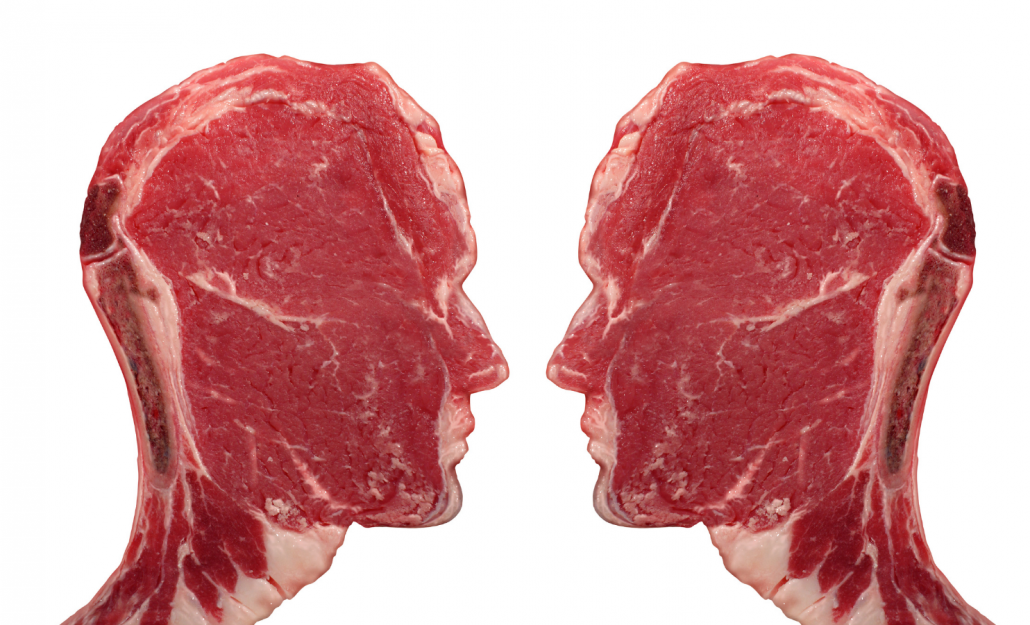
Table of Contents
Are humans carnivores? You probably think you already know the answer; humans are omnivores. Right?
Your elementary school science teacher drilled the classifications into your head. You studied teeth structure, eye location, and the presence of claws or talons in various mammals to decide who ate what.
But what if things aren’t quite that simple? There’s a big difference between “can” and “should” when it comes to eating meat.
Modern society has provided endless options when it comes to mealtime. Yet when we carefully consider what our bodies are designed to eat, and what energy source allows us to function optimally, the evidence points to one conclusion:
Humans are indeed carnivores.
What is a Carnivore?
When you think about the word carnivore, what comes to mind? Most people envision a pride of lions hunting zebras in the Serengeti, isolating the weakest member of the herd and savagely ripping its throat with razor-sharp teeth before a bloody feast. In truth, there’s a carnivore a little nearer and dearer to all of us. You only need to look in the mirror to catch a glimpse. Humans are carnivores.
A carnivore is an organism (mostly animals) that derives its food and energy requirements exclusively (or nearly so) from the tissue and meat of other animals. “Carnivore” quite literally translates into meat-eater from the Latin “caro” and “varorare”. But there is more than one type of carnivore.
Different Types of Carnivores
As one might expect, carnivores can be categorized by the importance meat plays in their overall diet:
- A Hypercarnivore or Obligate Carnivore is an animal that derives more than 70% of its calorie intake from animal foods.
- A Mesocarnivore derives about 50% of essential nutrients from animal foods in order to survive.
- Animals whose diet is only about 30% meat are called Hypocarnivores.
- Finally, Facultative Carnivores, the category in which humans belong, prioritize the consumption of animal foods but can survive (but not thrive . . . more on this later) on vegetables. Wolves and dogs are also facultative carnivores.
At this point, many of you are probably asking, “But I thought humans were omnivores?” While humans do eat just about anything, that doesn’t mean we should. It also doesn’t mean that our bodies function optimally while we’re eating whatever and whenever we want. If the current health crisis of overweight, diabetic, diseased, and inflamed Americans is any indication, we most definitely should not be eating everything and anything. In the words of the late, great Barry Groves, a true health crusader, “Civilized man is the only animal clever enough to manufacture its own food, and the only animal stupid enough to eat it.”
Essential Nutrients – Evidence that Humans are Carnivores
Why is meat a necessity? Our bodies can manufacture a lot of different biomolecules, but not all of them. The ones we can’t produce are called essential nutrients, which means we must obtain them through diet or, to be blunt, we die.
Fatty acids like Omega 3 and Omega 6 are essential. Many amino acids (protein) are essential. And there are a handful of essential vitamins and minerals like vitamins A, B, C, E, and K, potassium, and sodium, along with several others.
However, there are no essential carbs. You can choose to eat zero carbs and continue to live a normal, healthy (and likely an even healthier) life.
Not surprisingly, all essential nutrients can be found in animal source foods. Not all essential nutrients can be found in plants.
The foods we eat provide the energy necessary for living in the form of calories. We get calories from three main sources: carbohydrates, protein, and fat.
Examples of Essential Nutrients
DHA
Docosahexaenoic acid (or DHA) is critical for brain function and makes up 20% of the fat in our brains. It allows for neural connectivity and protects our nerves. Only animal source foods provide DHA in sufficient quantities.
In addition to fatty acids, the brain requires various vitamins and minerals to extract energy and perform other bodily functions.
Vitamin A
Vitamin A regulates 500+ genes and stem cell differentiation and is found abundantly in beef liver and eggs. Beta Carotene is a Vitamin A precursor found in plant foods, but the bioavailability is pitiful compared to preformed Vitamin A.
B Vitamins
B Vitamins help convert fuel to energy and create the red blood cells that transport oxygen to our brains. B vitamins can also affect moods. Most people are deficient in vitamin B, which has been linked to depression. Again, beef liver is an abundant source of vitamin B. Vitamin B12 is almost exclusively found in animal products.
Vitamin K2
Vitamin K2 helps to regulate calcium in our bones and brains. It can help prevent heart disease and deficits in vitamin K2 have been linked to Alzheimer’s disease.
Choline
Choline helps maintain the structure of cell membranes, which is responsible for memory and mental clarity. Deficits in choline can lead to cognitive impairments and problems with concentration and memory. Our bodies make a small amount of choline, but most must come from food.
Iron
Iron helps our cells generate energy, fight harmful pathogens, and circulate oxygen throughout the body.
Copper
Copper regulates energy production, brain function, and iron metabolism.
Zinc
Zinc aids in serotonin synthesis and dopamine transport.
Iodine
Iodine is necessary for synthesizing thyroid hormones, which are critical for brain growth and development. Fish, salmon roe, and eggs are all good dietary sources of iodine.
It can’t go without mention that for so many of these essential vitamins, beef liver is the most abundant food source available. Take a look at how beef and beef liver stack up to some tried and true “superfoods.”
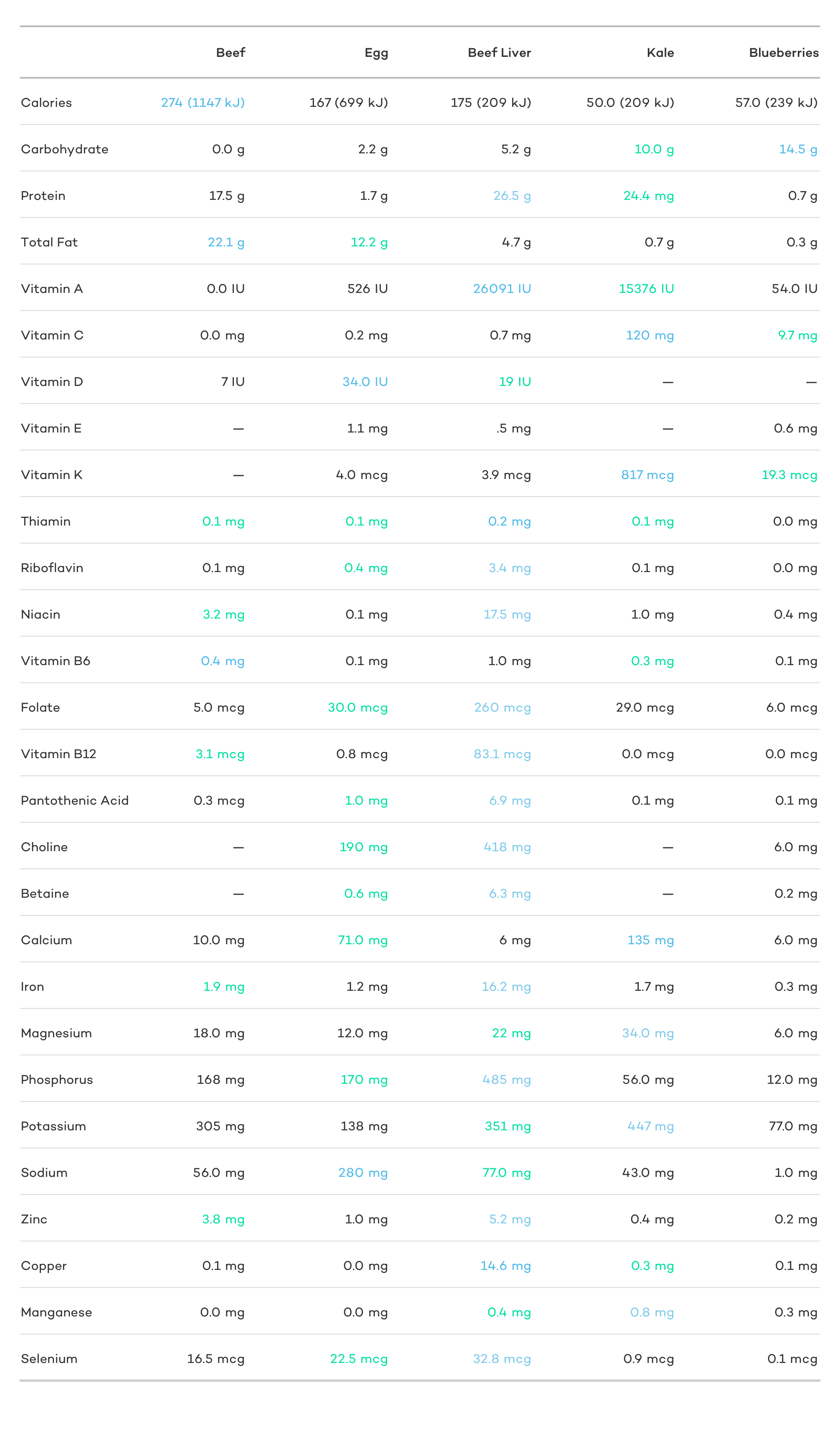 Similarly, take a look at how a standard carnivore’s day of eating easily surpasses just about all recommended daily values.
Similarly, take a look at how a standard carnivore’s day of eating easily surpasses just about all recommended daily values. 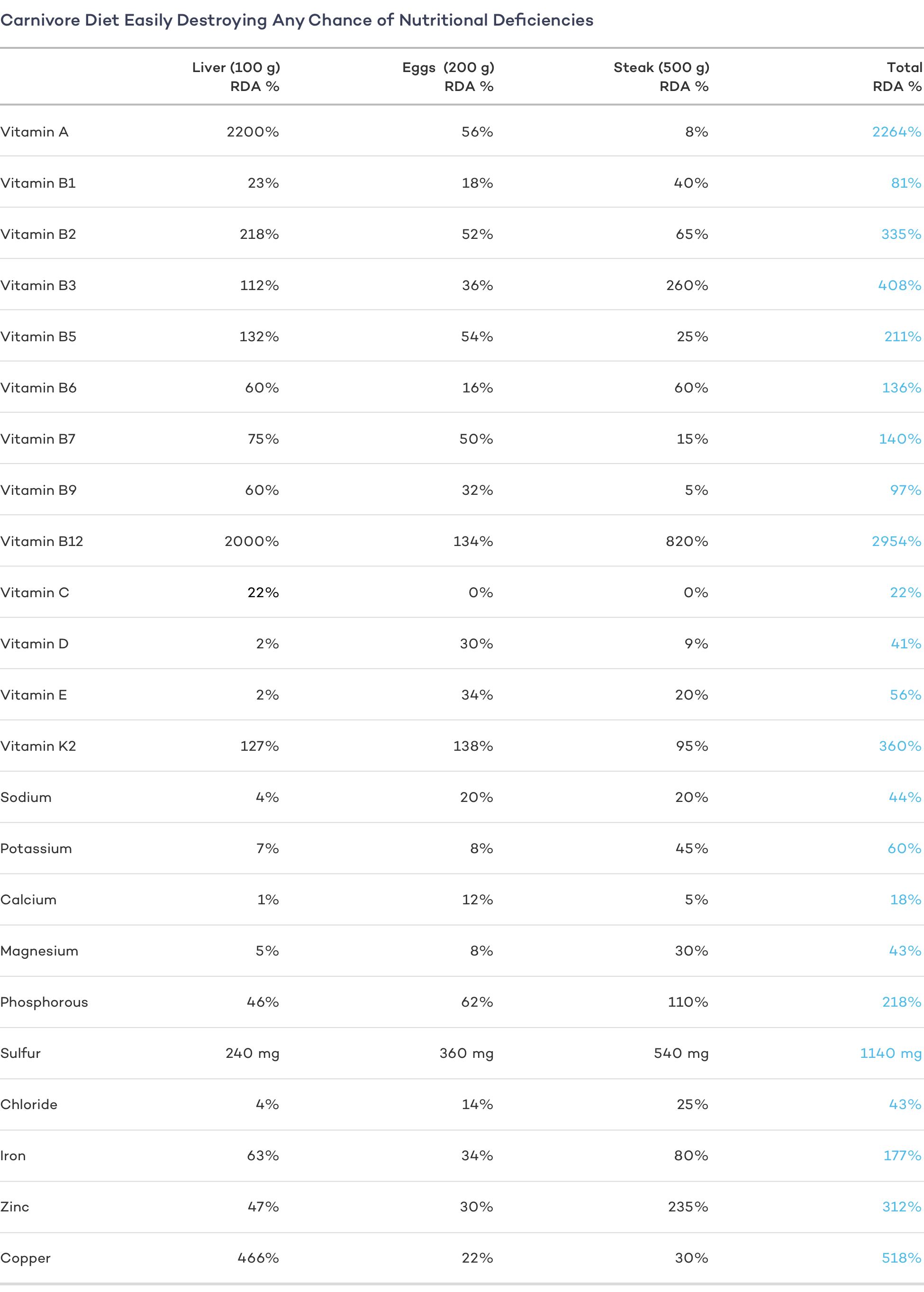
Given that 9/10 people eating a standard American diet are missing key nutrients, seems like just about everyone should be shifting to a carnivore diet that clearly provides adequate nutrition.
While plants can provide some essential nutrients, most are far more bioavailable in animal meat than in vegetables or supplements. Just because you consume various nutrients doesn’t mean that 100 percent of them find their way into your bloodstream and cells. The body can only utilize a portion of the nutrients it takes in—a principle called bioavailability. How much of a given nutrient your body ultimately absorbs is influenced by many factors, the most important of which is the source.
Take spinach, for example, which like beef liver, is seemingly an excellent source of iron; however, spinach also contains oxalates, as do many green leafy vegetables, that bind to minerals and interfere with the body’s ability to absorb them.
Even the most diligent vegetarians can’t fulfill nutritional requirements from plant sources alone. The chart below shows that the energy yield from animal products far exceeds what is provided by plants.
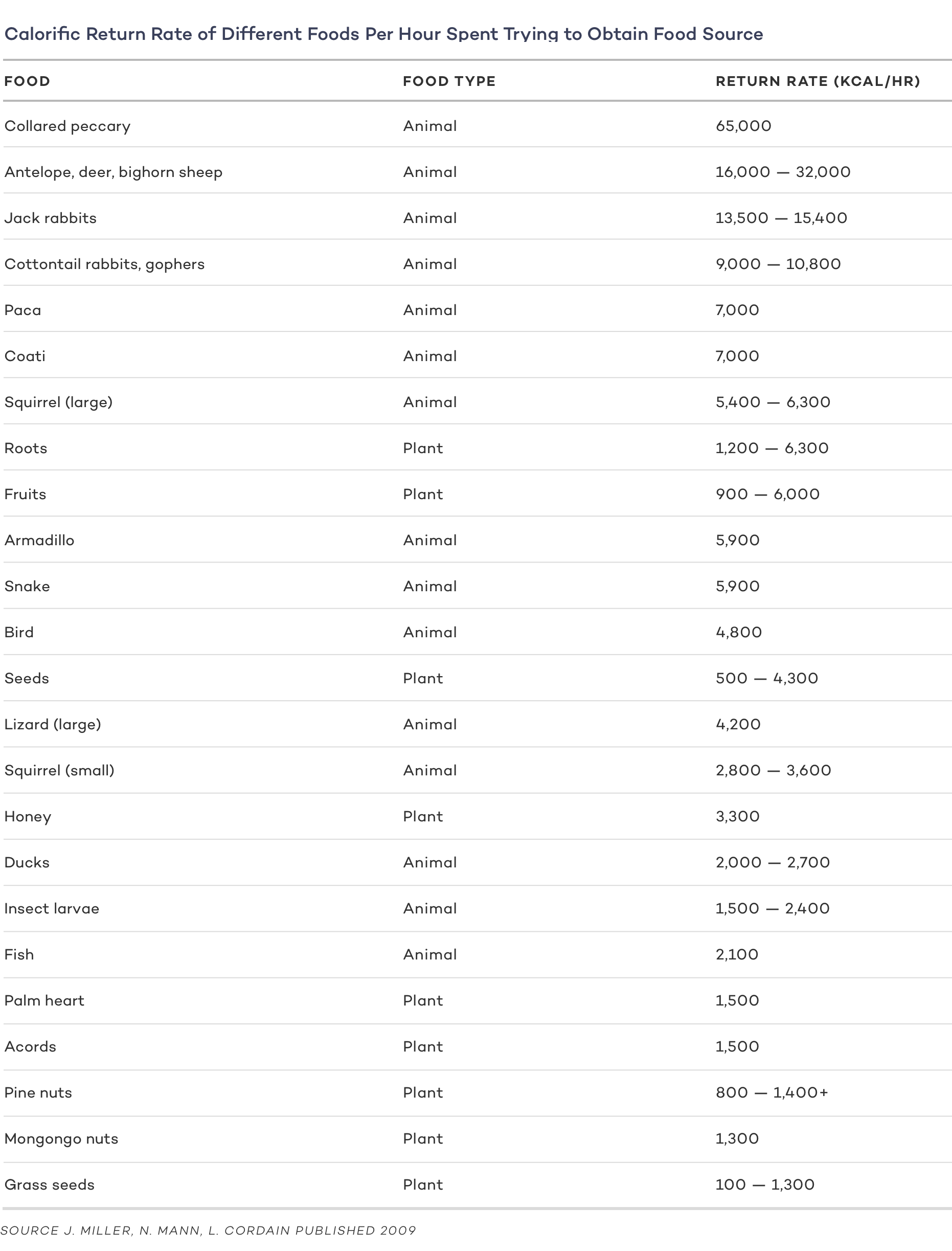
There is no nutrient in plant foods that cannot be found in animals. But there are a few crucial nutrients that are impossible or very difficult to get insufficient amounts from commonly consumed plant foods. These include:
- Vitamin A
- Vitamin B12
- Creatine
- Carnosine
- Vitamin D3 (Cholecalciferol)
- Vitamin K2
- Docosahexaenoic acid (DHA)
- Heme Iron
- Taurine
Other Evidence that Shows Humans are Carnivores
Though we have evolved from grass, shrub, and fruit eaters, the human body in its current form is designed to eat and run on meat. And if we take a look back at human evolution, it’s easy to see how and why we have developed into carnivores.
A groundbreaking 2021 study by Israeli researchers found that humans spent 2 million years as “hyper-carnivorous” apex predators that ate mostly the meat of large animals.
The study took into account a broad range of evidence, like genetic coding for a fat-rich diet, isotopes in bones of pre-historic humans showing the consumption of high-fat diets, likely from large animals, and the late appearance of tools for processing plant foods.
Researcher Miki Ben-Dor concludes that, “archeological evidence…supports the centrality of large animals in the human diet, throughout most of human history.”
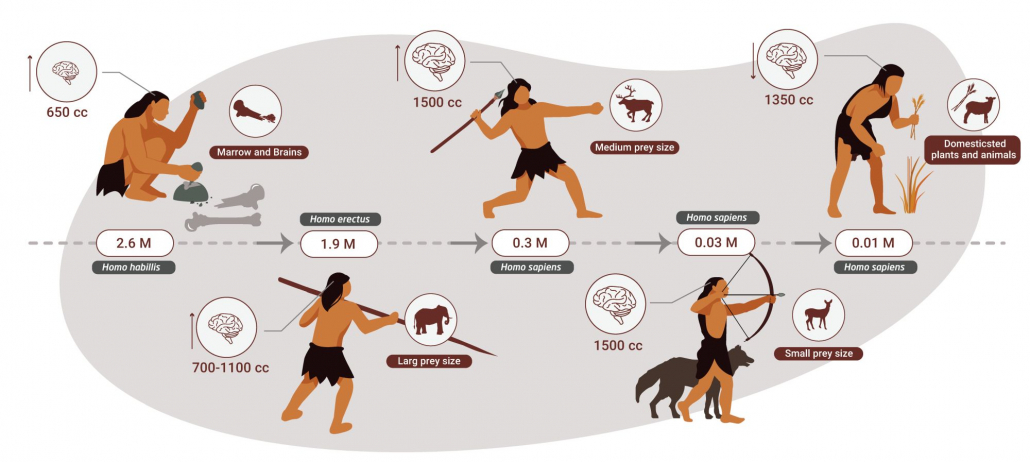
Development of the human brain in relation to food sources and hunting practices. Source: Times of Israel
Humans Have Small Fat Cells Like All Carnivores
Carnivores are shown to have a higher number of smaller fat cells, while omnivores have a smaller number of larger fat cells. Humans have many small fat cells like all carnivores. After comparing the fat cells in various types of animals, researchers found humans to be at the top of the carnivorous pattern, which suggests that the humans’ energy metabolism is adapted to a diet in which lipids and proteins contribute most of the energy supply, rather than carbohydrates.
Humans Have a Stomach Acidity That is Unique to Carnivores
Humans have a high stomach acidity level (a pH of 1.5) that puts us somewhere between obligate and facultative scavengers. Herbivorous primates have a stomach pH of around 4 to 6. Most omnivores are between 2 and 4. Maintaining this level of acidity requires a lot of energy, as does retaining the stomach walls to contain that acidity. Presumably, humans would only evolve to this point if the bacteria levels in our diet were high enough to warrant the adaptation.
Humans Have a Smaller Gut Than Other Primates
Compared to our similarly-sized chimpanzee ancestors, humans have a large intestine (where fiber is processed) that is about 77% smaller by volume. This significantly reduces our ability to extract energy from plants.
On the flip side, our small intestine (where macronutrients are absorbed) is about 62% larger than chimpanzees. This gut morphology is an adaptation that favors meat consumption over plants. As humans evolved, we gave up our ability to ferment fiber into fat and developed smaller colons as a trade-off for increasing our brain size.
Humans Have Adapted to Throwing Rather Than Climbing
Humans are the most dangerous animal with an unrivaled hunting prowess. Unlike our primate ancestors who continue to have shoulders adapted for climbing and swinging from trees, humans are the only species that can throw objects with incredible speed and accuracy–an evolutionary change that Human Evolutionary Biologist Neil Thomas Roach believes was an adaptation to carnivory.
He proposes that “this ability to produce powerful throws was crucial to the intensification of hunting that we see in the archaeological record at this time. Success at hunting allowed our ancestors to become part-time carnivores, eating more calorie-rich meat and fat and dramatically improving the quality of their diet.” You don’t need to spend hours throwing rocks at an apple in a tree when you can simply climb up and grab it.
These dietary changes subsequently led to humans growing larger bodies, larger brains, and the ability to have more children.
Humans Have Much Higher Fat Reserves Than Chimps
Carrying a higher amount of fat consumes energy and impairs our ability to chase or flee, but it also provides an insurance policy for survival during periods of food scarcity. If we only lived in the tropics and were constantly eating plants–like other primates, we wouldn’t have adapted this way.
Our Jaws and Teeth Have Become Smaller, Forgoing Chewing Capabilities
While most carnivores boast large fangs or teeth, the invention of tools meant we didn’t need to tear raw flesh from a carcass with our bare teeth. We know early humans crafted tools to help process meat. It takes 39% to 46% less force to chew and swallow processed meat than processed root foods. Evolution chose to forgo the ability to properly chew certain plant-based foods to allow for more room in the skull for our growing brains.
Our Growing Brains Depended on Animal Products
Our brains are energy hogs and require lots of energy to function. The fatty acids found in animals (AA, DTA, DHA, EPA) compose 90% of our brains and are not available in plants.
As a result of all of these adaptations, it is clear that humans have been moving further from herbivory/omnivory and closer to carnivory. And we didn’t just evolve to eat meat; we evolved because we ate meat.
In fact, since our prehistoric beginnings, our brains quadrupled in size. And now since the agricultural revolution and the development of processed foods, our brains have begun to shrink.
Humans Need Animal Meat for Energy Requirements
As our bodies evolved and our energy needs increased to support higher brain function, plants (aka carbs) no longer fulfilled these requirements. The most readily available source of energy was large animals, aka megafauna. The meat and fat of these animals easily fulfilled our energy needs without the need for plants. It’s interesting to note that even today, the most diligent vegetarians can’t get all the nutrients their bodies need from vegetable sources alone.
Not surprisingly, our ancestors have long appreciated the value of fatty meat. Researchers studying aboriginal tribes in the late 1800s to early 1900s noted that tribesmen would not eat vegetables when animal sources were available, and children were always offered the fattiest meat first. Many modern aboriginals eat solely (or almost exclusively) meat.

Source . The paradoxical nature of hunter-gatherer diets: Meat-based, yet non-atherogenic, April 2002, European Journal of Clinical Nutrition 56 Suppl 1(Suppl 1):S42-52
All Animals Need Fat: A Look at the Herbivore’s Diet
For those who point to gorillas as close relatives who indeed survive and thrive on a plant-based diet and think we should be able to as well, it’s important to note that all animals need fat. They don’t necessarily need to consume fat, but their bodies need to be able to convert their diet to fat. Gorillas do just this. Gorillas eat a ton of fiber that is mostly protein and carbs. But the interesting thing is that their digestive system, which is composed of a large cecum and colon, contains bacteria that ferments this fiber into short-chain fatty acids. When you look at what ultimately gets absorbed into a gorilla’s body and converted into energy, the short-chain fatty acids provide 60-70% of the gorillas’ energy. The digestive systems of cows accomplishes a similar feat. Some might even say that, from a pure absorption perspective, herbivores are actually carnivores.
Weaning Time
In comparison to our ape ancestors, humans wean their young at a much younger age. In fact, early weaning is one of the main differences between the genus Homo and the great apes. In modern societies where infants rely on their mother’s milk and not bottle feeding, babies nurse for two to three years.
By contrast, great ape mothers nurse their young for four to six years. In Psouni et al’s study Impact of Carnivory on Human Development and Evolution Revealed by a New Unifying Model of Weaning in Mammals,their analysis showed that carnivores systematically wean earlier than omnivores and herbivores and that carnivory may be a fundamental determinant of the early human weaning. The meat-based diet of our early human ancestors changed the weaning behavior of man and the course of evolution.
Obvious Human Geographical Location and Food Scarcity
The carnivorous life is indeed a healthy one. We have examples of many cultures that have thrived on fatty meat and protein from animals because access to plants was limited or non-existent for most of the year. The Inuit (or Eskimos) Extremely limited access to plants for much of the year, yet they survive and thrive. How have they survive?
Similarly, most cultures’ from the equator experienced a long period of little to no agricultural productivity each and every year.
Carnivore Societies that show Humans are Carnivores
There are several remaining carnivore tribes who have eaten meat-based diets and have avoided most of the modern diseases of human civilization despite NOT eating a varied diet of fruits, vegetables, grains, and lean meats.
Maasai
The Maasai tribe in Africa consumed milk, blood, and meat as their primary sustenance. They had low levels of serum cholesterol and were very healthy with little to no heart disease despite consuming 600mg – 2000mg of cholesterol a day — twice the daily health recommendation.
Inuit Eskimos
Survived on caribou, fish, seal, polar bear, rabbits, birds, eggs, and very little in the way of fruits and vegetables, with the exception of the occasional berry. Researchers back in the 1950s concluded that this meat-centric diet caused Eskimos just a fraction of the heart disease seen in America at the time.
Mongols
Because the Mongolian steppe has one of the most extreme climates in the world, it’s not favorable to agriculture whatsoever. Meat was the only consistent energy source. The Mongols enjoyed lots of animal fat and ate the entire animal from end to end. There was no waste. Vegetables were considered goat food and not desirable. Despite their harsh climate, they were able to thrive, survive, and conquer many other civilizations.
Plains Indians
Buffalo was a diet mainstay for the Sioux, Mandans, Comanche tribes. Researchers found them to be remarkably healthy. They were tall, had good dental health, and considered to be in superior health to their white counterparts.
For most of these tribes, this good health was not a genetic mutation but rather a result of a meat-dense diet. In future generations, as western ways of eating crept into these societies, they experienced the same ill effects as westerners. For example, as the Inuits began to alter their diet in the 20th century to include store-bought, processed foods, this led to new health problems.
Surviving, Not Thriving
As mentioned previously, humans can undoubtedly eat just about every food group, including processed, man-made concoctions, but that doesn’t mean we thrive on this type of diet.
While humans as a species do live longer than ever before, we now suffer from certain illnesses to a degree never before seen in the past — including rates of diabetes and obesity and, surprisingly, ailments such as hay fever that continue to climb. When populations around the globe started converting to agriculture around 10,000 years ago, regardless of their locations and what they were growing, a similar trend occurred: The height and health of the people declined.
On the advice of medical experts, we’ve eliminated most of the healthiest food in our diets, such as fatty red meat, pork, eggs, bacon, and supplemented the fats with grass, grains, fruits, fibers, vegetables, and plant oils. Despite following nutritional recommendations from the experts, we haven’t become healthier. The number of people suffering from Crohn’s Disease, Irritable Bowel, and other autoimmune diseases has skyrocketed. Today, the NIH estimates that over 23 million Americans suffer from an autoimmune disease. We may be living longer, but we sure aren’t living healthier.
Diseases of Human Civilization
There is significant scientific evidence positively correlates Western diet to acne, obesity, diabetes, heart disease, stroke, metabolic syndrome, and cancer, Alzheimer’s, and the so-called “diseases of civilization”.
The consumption of processed foods has been a major driver of chronic disease, spurred by vegetable/seed oils, refined wheat flour, trans fats, and sugar consumption, the core components in processed foods. Nearly three-quarters of our diet is made up of nutrient deficient, toxic processed foods.
The Final Verdict
Humans have evolved to eat meat because it was the source of fuel we required to become the brainier, more skilled apex predators that we are. We can survive on meat alone. We don’t require the fiber, sugar, carbs, phytochemicals, and toxins that come from fruits and vegetables.
We eat non-meat foods not because they’re essential, but because they are readily available and we’ve been brainwashed to consider them necessary components of a healthy diet.
Like the lion and lioness in the jungle, meat is the only food humans need to thrive and survive. Evolution has ensured we have the ideal digestive system for processing a carnivorous diet. Now it’s up to us to accept this fact and eat what we’re designed for.













